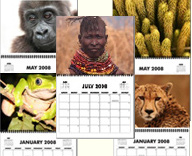
|
About | Contact | Mongabay on Facebook | Mongabay on Twitter | Subscribe |
|
|
|
How Genghis Kahn cooled the planet Jeremy Hance mongabay.com January 20, 2011
"It's a common misconception that the human impact on climate began with the large-scale burning of coal and oil in the industrial era," says Pongratz, lead author of the study in a press release. "Actually, humans started to influence the environment thousands of years ago by changing the vegetation cover of the Earth‘s landscapes when we cleared forests for agriculture." The answer to how this happened can be told in one word: reforestation. When the Mongol hordes invaded Asia, the Middle East, and Europe they left behind a massive body count, depopulating many regions. With less people, large swathes of cultivated fields eventually returned to forests, absorbing carbon dioxide from the atmosphere. In the study published in The Holocene, Pongratz along with Carnegie colleague, Ken Caldeira, and German colleagues at the Max Planck Institute for Meteorology, compiled a model of global land cover beginning in 800 AD. She kept her eye on four historical events closely, which she theorized could have impacted the climate due to the return of forests after depopulation: the Black Death in Europe (the end of the 14th Century), the fall of China's Ming Dynasty (the last half of the 17th Century), the conquest of the Americas (the 16th and 17th Centuries), and the Mongol invasion of the 13th and 14th Century. "We found that during the short events such as the Black Death and the Ming Dynasty collapse, the forest re-growth wasn't enough to overcome the emissions from decaying material in the soil," explains Pongratz. "But during the longer-lasting ones like the Mongol invasion and the conquest of the Americas there was enough time for the forests to re-grow and absorb significant amounts of carbon." The Mongol invasion had the most significant impact. According to the study's accounting, re-growth of forests during the Mongol invasion absorbed 700 million tons of carbon from the atmosphere, equaling the amount of carbon global society now produces annually from gasoline. Pongratz argues that her study has relevance for the world's current climate crisis: "Today about a quarter of the net primary production on the Earth’s land surface is used by humans in some way, mostly through agriculture. […]. In the past we have had a substantial impact on global climate and the carbon cycle, but it was all unintentional. Based on the knowledge we have gained from the past, we are now in a position to make land-use decisions that will diminish our impact on climate and the carbon cycle. We cannot ignore the knowledge we have gained." Of course, before society can even consider global reforestation, global deforestation must be halted. Despite worldwide concern and numerous initiatives over the years (both local and global) forests continue to fall at staggering rates. Currently around 10% of the world's greenhouse gas emissions come from deforestation.
Related articles
|
WEEKLY NEWSLETTER 
HIGH RESOLUTION PHOTOS / PRINTS 
CALENDARS 
CANVAS BAGS 
|
|
Copyright mongabay 2010 Carbon dioxide (CO2) emissions generated from mongabay.com operations (server, data transfer, travel) are mitigated through an association with Anthrotect, an organization working with Afro-indigenous and Embera communities to protect forests in Colombia's Darien region. Anthrotect is protecting the habitat of mongabay's mascot: the scale-crested pygmy tyrant. |
 (11/02/2010) Food produced in the tropics comes with high carbon emissions and low crop yields, according to a new study in the Proceedings of the National Academy of Sciences (PNAS). In the most comprehensive and detailed study to date looking at carbon emissions versus crop yields, researchers found that food produced in the tropics releases almost double the amount of carbon while producing half the yield as food produced in temperate regions. In other words, temperate food production is three times more efficient in terms of yield and carbon emissions.
(11/02/2010) Food produced in the tropics comes with high carbon emissions and low crop yields, according to a new study in the Proceedings of the National Academy of Sciences (PNAS). In the most comprehensive and detailed study to date looking at carbon emissions versus crop yields, researchers found that food produced in the tropics releases almost double the amount of carbon while producing half the yield as food produced in temperate regions. In other words, temperate food production is three times more efficient in terms of yield and carbon emissions.